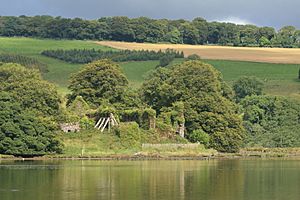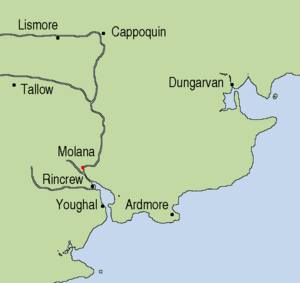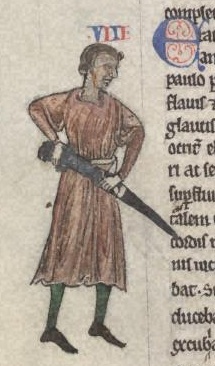Molana Abbey facts for kids
Molana Abbey is an ancient monastery from the 6th century. It's located on the south coast of Ireland, close to a town called Youghal. This abbey sits on what used to be an island in the River Blackwater.
Monks lived here for many centuries. In the 8th century, they even helped put together an important collection of church laws called the Collectio canonum Hibernensis. Later, in the 12th century, a group of monks called Augustinian canons took over the abbey. However, during a time called the Reformation, the English king took control of the abbey, and it slowly turned into ruins.
Contents
What's in a Name? The Story of Molana Abbey
The original Irish name for the island where the monastery was built was Dairinis. This means "Oak Island," probably because there were many oak trees there. Old texts from the Middle Ages also called the abbey by this name.
But there was another monastery called Dairinis in Wexford. To avoid confusion, people started adding the name of the founder, Máel Anfaid, to the abbey's name. Over time, the old Irish name was dropped, and only the founder's name was used. This name was later changed to "Molana" when English became more common.
Where is Molana Abbey Located?
Molana Abbey is on what was once an island in the Blackwater River. In 1806, two dams were built. These dams connected the island to the mainland.
The abbey is only a few kilometers from where the river meets the sea, near the natural port of Youghal. Being close to waterways was very important in the early Middle Ages. It made it easy for monks to travel to other monasteries in Ireland, Britain, and even Brittany (a region in France). It's believed the monks at Molana used small boats called currachs for their journeys. Some old stories say that a sea trip between southern Ireland and Brittany could be done in just three days and nights!
The History of Molana Abbey
The monastery was founded in the 6th century by a man named Máel Anfaid. He was a student of Saint Carthage. Not much is known about Máel Anfaid, but he might have lived until at least 608 AD. The early monastery was famous for its large library, which even had Greek texts and church rules from Africa.
It's likely that Molana Abbey, like many other Irish monasteries, was attacked by Vikings. Its location near the mouth of the Blackwater River would have made it an easy target. However, no records of these attacks have survived.
Norman Influence and Changes
After the Norman Invasion of Ireland in 1169, the monks at Molana became friends with Raymond Fitzgerald. He was an important Norman military leader. FitzGerald supported the monastery, and it's thought he was buried there sometime between 1185 and 1198.
In the 12th century, Molana Abbey became a home for Augustinian canons. The monastery was rebuilt and made much larger in the 13th century. By 1462, even though the buildings were in poor condition, many monks still lived there. They cared for the poor and the sick. In 1475, it was reported that the monastery was still struggling financially but continued its work.
The Reformation and Decline
During the Reformation, King Henry VIII of England took control of all monasteries in his lands. A report from 1541 described Molana Abbey. It had a church, a cloister (an open area surrounded by covered walkways), and everything needed for farming. This included 380 acres of land, three weirs (traps for catching fish like salmon), and a water mill. The property was valued at about 26 pounds and 15 shillings.
On December 21, 1550, the monastery's ownership was given to James FitzGerald, 14th Earl of Desmond. The Earl allowed the monks to continue living there. However, during the Desmond Rebellions, the English Crown took the monastery back. In 1580, English soldiers visited the island. They damaged the church and burned a painting of the monastery's founder.
By 1600, the monastery was empty and covered in so much ivy that it was hard to see its original design. The buildings slowly fell into ruin.
Later Ownership and Preservation
The land and ruins were owned by Richard Boyle, 3rd Earl of Burlington until the mid-1700s. Then, they passed to the Smyth family. This family built a large house nearby called Ballynatray House in 1795, surrounded by a beautiful park. To make the monastery ruins part of their park, the Smyth family built two dams in 1806. These dams connected the island to the mainland, as they still do today.
The monastery and its manor house have been sold several times and are still privately owned. However, the grounds of Ballynatray House are sometimes open to the public for a few hours.
The Architecture of Molana Abbey
We don't know much about the buildings from the very early Christian times. Back then, people usually built with materials found nearby. Since the island was called "Oak Island," the first monastery was probably made of oak trees. Later, before the Normans arrived in the 12th century, churches started to be built with stone.
The main part of the church, called the nave, dates back to this time. It is about 17 meters long and 7.5 meters wide. The builders used large, carefully chosen stones to make the walls very strong and precise.
Later Additions and Features
Most of the other buildings we see today were built in the 13th century, with some changes made later. The windows in the choir (the part of the church where the monks sang) are very tall, about 4.5 meters high. They are wide at the inside and narrow towards the outside. With six windows on the south side, a large window on the east, and four on the north, the choir would have been very bright. In contrast, the older nave must have been quite dark.
The east wing of the monastery had two floors. The ground floor was next to the choir vestry (a room for robes). Further south were other areas, including the chapter house (where monks met). A staircase led from here to the dormitory (sleeping area) on the top floor. The chapter house had a three-part window.
The refectory (dining hall) was very long, about 21.5 meters, and 6 meters wide, taking up the entire southern wing. Today, large parts of its southern wall have fallen down. However, a section with an early English-style window remains. This window had an arch and likely served as a lectern (a stand for reading). With two windows in the west wall, the refectory would have had good light.
Changes by the Smyth Family
In the early 1800s, the Smyth family made some changes to the ruins. These include a pointed arch entrance on the north side of the old church hall. They also added a statue of the founder, Máel Anfaid, dressed as an Augustinian Canons Regular, which isn't historically accurate for his time. A memorial plaque on the east wall of the refectory claims to be the burial place of Raymond Fitzgerald, but it's believed he was buried in a different part of the monastery.





